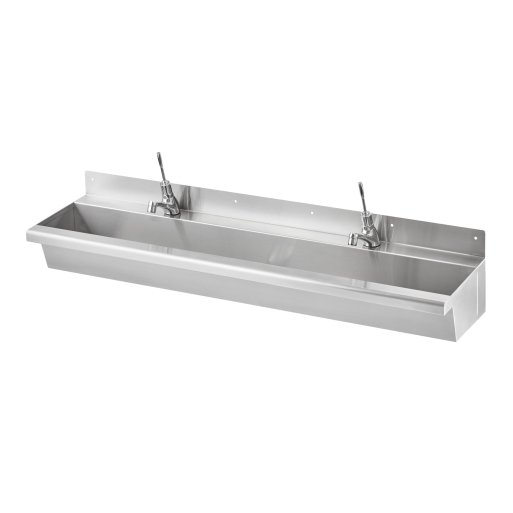Wash troughs: what they are and when to use them.
A wash trough is a long, narrow basin designed for communal handwashing. Unlike normal sinks, which are filled by the user with a mixture of hot and cold water, wash troughs do not fill up; instead, premixed water is delivered at hand-washing temperature via mixer taps in conjunction with a thermostatic mixing valve.
Normally constructed from stainless steel or solid surface resin, wash troughs offer a space-saving and cost-effective alternative to individual handwashing basins.
Uses
Wash troughs are most commonly used for handwashing in toilet facilities, whether public or commercial. They are also used in workplaces where employees tend to get their hands dirty, such as garages and factories, or where hygiene is paramount, such as GP surgeries and hospitals. They are also often found at attractions where visitors interact with animals, such as city farms and petting zoos.
![]()
Trough sinks are also popular in schools - in fact, guidance from the Department for Education and Skills states that troughs are preferable to individual handwashing basins in a school setting, not only because they are easier to clean, but also because they make it more difficult for pupils to flood the toilets (kids, eh?).
Savings
It’s not difficult to see why washtroughs are so much cheaper than individual handwashing basins. For one thing, wash troughs can accommodate several users at a time, meaning that you’ll only need to purchase one or two units per washroom, depending on its size.
They are also cheaper and less time-consuming to install. Each trough unit requires just one waste fitting, one trap, and one waste pipe connection; given that a single wash trough will accommodate as many users as three or four individual basins, each of which would require its own waste fitting, trap and waste pipe connection, then the potential installation and maintenance savings are obvious.
Installation
Before you take the plunge and purchase a wash trough, you should think about how many people will be using it, and how much room to allow per person. As a rule of thumb you should aim to provide 500 to 600mm per user for adults, although if your users need to wash up to the elbow (e.g. doctors or mechanics), then you should allow a little more room - we normally recommend 750 to 800mm per person.
For nurseries and preschools, we would recommend allowing 450 to 600mm for juniors, and 300 to 450mm for infants.
While there are no hard-and-fast rules for how high to install a wash trough, Cornwall Council recommends a mounting height of 810mm for adults, 790mm for secondary school pupils, 690mm for juniors, and 610mm for infants, which we agree are reasonable guideline recommendations.
Styles
Available in several finishes and styles, Stainless steel wash troughs are exceptionally easy to clean and maintain. Powder coated stainless steel wash troughs come in a range of vibrant colours, which makes them ideal for schools and nurseries.
The sleek finish of a solid surface wash trough can give a contemporary, minimalist feel to any washroom, while our solid surface nursery school wash trough is designed specifically with younger children in mind.
All mixed up
Because it isn’t possible to fill a wash trough with water, like a normal sink, you’ll need to install mixer taps, preferably in conjunction with a TMV3 pre-mixing water valve. TMV3 valves ensure that the water never exceeds a set maximum temperature. They are optional in most cases, but they can be a legal requirement in facilities with vulnerable users, such as schools, care homes and hospitals.
Mixer taps will mix hot and cold water adequately, but using a TMV3 means that water maintains a constant temperature, even in the face of fluctuating temperature and pressure in the main water supply. It will also shut off automatically in the event of a hot or cold water supply failure.
For a more comprehensive overview of the wash troughs we offer, please feel free to take a look at our wash trough page.
-
Posted by Paul Thorn
10th February 2018

 UK's Largest Stockholding
UK's Largest Stockholding Next Day Delivery Available
Next Day Delivery Available UK Mainland Delivery from £15
UK Mainland Delivery from £15 Minimum 1 Year Guarantee
Minimum 1 Year Guarantee